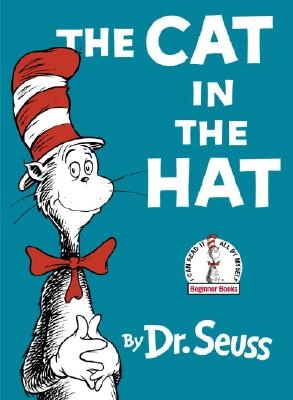
Published in 1957 by Random House
“The Cat in the Hat and Ted Geisel were inseparable and the same. I think there’s no question about it. This is someone who delighted in the chaos of life, who delighted in the seeming insanity of the world around him.”– Michael Frith, Random House editor
SUMMARY:
The story opens with a young boy and his sister, Sally, sitting inside staring out the window on a rainy day.
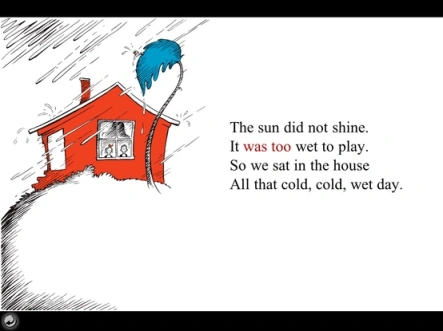
The young boy exclaims, “How I wish we had something to do!” but it is too wet to play outside so they sit inside doing nothing at all. Just sitting. When all of a sudden they hear a big “BUMP!” and in walks a cat in a hat. The Cat in the Hat tells them they can have lots of “good fun that is funny!”
Then the children’s fish gets very upset and wants the cat to leave because,
“He should not be here,But the cat reassures the fish that his tricks are not bad and that he knows lots of fun games. His first game is balancing on a ball while holding several random items such as the fish, a teacup, an umbrella, a book, a rake and a cake, a fan and a toy man.
He should not be about,
He should not be here,
When your mother is out!”
Just at the height of his impressiveness the cat falls from the ball and all the items rain down on the children leaving a huge mess! The fish is even more upset and adamant that this is all a bad idea and that the cat should leave. The Cat in the Hat says he does not wish to go and has another good game lined up.
He comes inside with a big box and when he lifts the hook Thing 1 and Thing 2 come running out.

They fly kites and wreak havoc, knocking over pots and stools and pictures and dragging around the children’s mother’s new gown. The young boy realizes,
“I do NOT like the way that they play!And just at that moment the fish sees their mother coming up the sidewalk! So, the young boy grabs his net and runs after Thing 1 and Thing 2 and captures them. The Cat in the Hat hauls them out in their box and the children are left with a massive mess.
If Mother could see this,
Oh, what would she say!”

Then the Cat in the Hat comes back with a cleaning up machine and exclaims,
“Have no fear of this mess…
I always pick up all my playthings.”
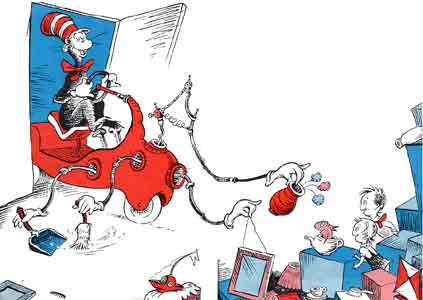
Just as the cat finishes cleaning the mother walks in to find her children sitting nicely in a clean house staring out the window with the fish calmly swimming in the bowl. She asks them,
“Did you have fun?Sally and her brother do not know what to say and the story ends with them asking the audience
Tell me.
What did you do?”
“Should we tell her about it?
Now, what SHOULD we do?
Well…What would YOU do,
If your mother asked YOU?”
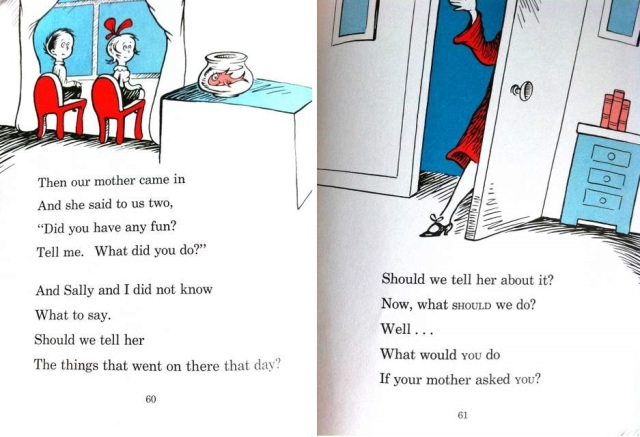
HISTORY:
This is the first Dr.Seuss children’s book to have no dedication.
In the mid 1950s several articles about illiteracy in American children were on the rise. A writer of one of these articles, William Spaulding, challenged Seuss to write/illustrate a book that 6 and 7 year olds could read on their own. Spaulding gave him a list of 225 words that he could use for the story. In some of the versions of how Seuss wrote Cat in the Hat, it took him up to a year. In one case he stated that the first two words that rhymed on the list would be his title. Those words, of course, were “cat” and “hat”.
The New York Herald Tribune Review:Similar to his creation of Horton Hatches an Egg, Seuss had actually drawn a cat in a hat before. In Bartholomew and the Oobleck, there is a cat with a rather tall hat very similar to The Cat in The Hat, it just lacks a brim and stripes. He has also drawn a fish in a bowl that is suspiciously similar to the one that scolds the Cat in the Hat. The fishes most notably appearance is in If I Ran the Circus, which was the book Seuss was working on when he received the list of 225 words.
“We were afraid that the limitations Dr.Seuss put upon himself might have shackled his marvelous inventiveness. Quite the contrary. Restricting his vocabulary…and shortening his verse story has given a certain riotous unity…that is pleasing.”
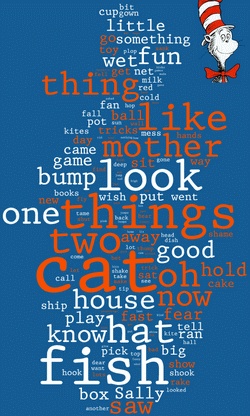
Above is a very well created image of all 225 words from Spaulding’s list with the size of the word being relative to how often it is used in the story.
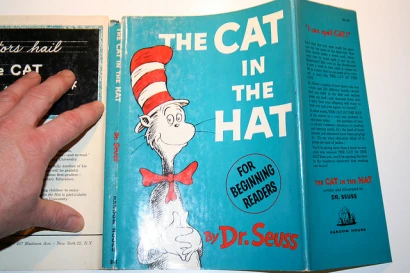
The original cover is the one at the top of this post and is still the most common cover. The third printing added a circle with “FOR BEGINNING READERS” on the cover and explained that the book is educational and helps children that are just learning to read. The back has reviews by educators and librarians to show how valid it is. The Random House logo is on the inside flap. This is interesting because this book marks the creation of the logo change for Random House’s children’s books. The character the Cat in the Hat quickly took over as the logo and is now seen on not only Dr. Seuss books but all of the Beginner Books that Random House publishes.
BEGINNER BOOKS:
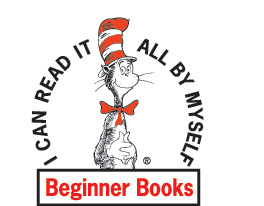
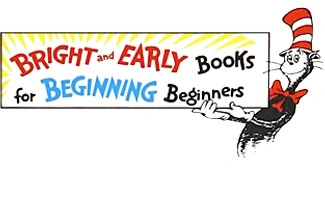
While The Cat in the Hat was in the process of being published, Phyllis Cerf, the wife of one of the founding members of Random House, approached Seuss about an idea she had. She wanted to create a division of Random House called Beginner Books that was dedicated to creating books for young children with the goal of helping them learn to read and WANT to read. Seuss was on board, but requested that his wife Helen be the third co-founder.
Helping children want to read was a passion for Seuss. On his visit to Japan Seuss had been surprised by how Japanese children would fill book stores and libraries and practically eat up the books. When he asked why this was, the answer he got was that Japanese children are raised with the concept that education is the key to a happier life so they read with a hunger that is related to survival. Seuss felt that it was too late to try to instill this hunger in American children so he felt the best way to solve the problem was to give children books that they want to read!
Seuss created a list of requirements for authors that wanted to be a part of Beginner Books. Each book was not allowed to have more than 200 words picked from a list of 379 words created by Cerf as the model for a young reader’s basic vocabulary. Seuss was also adamant that authors could not write anything that wasn’t also illustrated so that children could follow the story by just looking at the pictures.
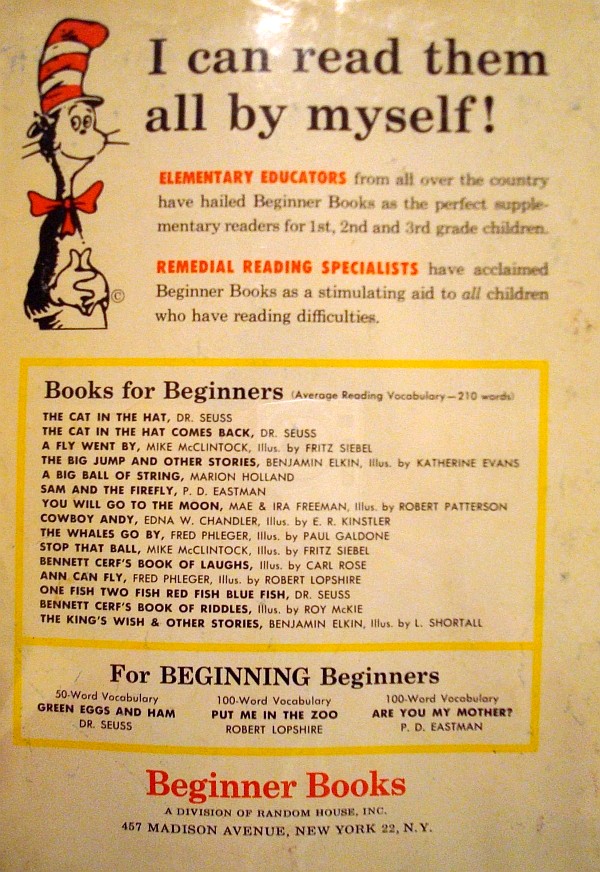
Some of the best known children’s books are part of Beginner Books. Because of the Cat in the Hat’s appearance in the logo these book are often mistaken for Dr. Seuss books; Go, Dog. Go! and Are You My Mother, by P.D. Eastman, are two of the books most often wrongly attributed to Dr. Seuss.
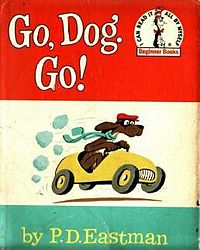
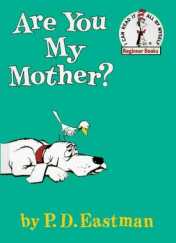
Stan and Jan Berenstain were guided by Seuss and quickly became successful in their own right, but they started out as authors for Beginner Books. The original illustrations were quite a bit different from the later illustrations that are now more recognizable, because of this some of the older books were republished with newer illustrations.

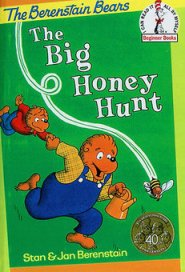
Seuss wrote several books for Beginner Books that he did not illustrate. He used the pen name, Theo. LeSieg to distinguish the difference.
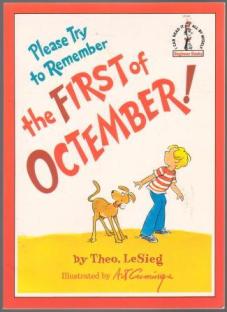
FAVORITE QUOTE:
My favorite quote from The Cat in the Hat is:
“I know it is wetLiving in the Pacific Northwest definitely makes this quote very relevant. There are many days were it is wet and not sunny, but you just have to think of some way to have fun that is funny!
And the sun is not sunny.
But we can have
Lots of good fun that is funny!”
FAVORITE IMAGE:
He may look drunk in this picture with his odd eye lid, but I really enjoy this image of the Cat in the Hat. It is chaos, but it is also fun and silly. Your eyes move across all of the objects trying to take it all in, which sums up the entire book rather well.
Thanks for reading,
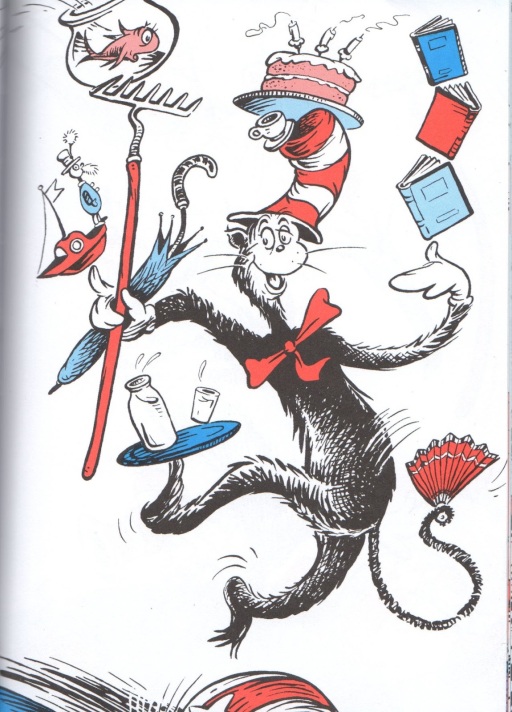
No comments:
Post a Comment